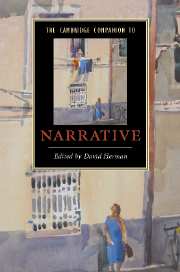Book contents
- Frontmatter
- Part I Preliminaries
- Part II Studying narrative fiction: a starter-kit
- Part III Other narrative media (a selection)
- 9 Conversational storytelling
- 10 Drama and narrative
- 11 Film and television narrative
- 12 Narrative and digital media
- Part IV Further contexts for narrative study
- Glossary
- Further reading
- Index
12 - Narrative and digital media
from Part III - Other narrative media (a selection)
Published online by Cambridge University Press: 28 September 2007
- Frontmatter
- Part I Preliminaries
- Part II Studying narrative fiction: a starter-kit
- Part III Other narrative media (a selection)
- 9 Conversational storytelling
- 10 Drama and narrative
- 11 Film and television narrative
- 12 Narrative and digital media
- Part IV Further contexts for narrative study
- Glossary
- Further reading
- Index
Summary
The computer can be used to extend or demolish traditional narrative concepts in all sorts of ways, but its ability to combine narration and simulation has been particularly significant in digital art, electronic literature, and video games. In narrating, computers represent events either by directly outputting narrative text, graphics, and sound or by generating this from some underlying representation of what has happened. In simulating, computers determine what happens in some model world, using a system of rules. Approaches developed by narrative scholars can provide specific insights into how simulation and narration function and interrelate in digital works.
Consider this excerpt from a transcript of interaction with Steven Meretzky’s 1985 interactive fiction A Mind Forever Voyaging – input from the user, also known as the interactor, is shown in italics:
>go northeast
Church Lobby
The regional central headquarters of the Church is an architectural splendor; light spills down from above, giving the illusion that the countenance of God is gazing down upon a visitor in full force and fury. A huge image of a radar dish, symbol of the Church, hangs above the inner sanctums to the east, and impressively tall arched doorways lead out to the northwest and southwest.
A wooden rack in the lobby, for the purpose of distributing literature about the church, contains one pamphlet.
WARNING: Record buffer full. Auto-deactivation of record feature.
>exit simulation mode
Aborting to Communications Mode
– SIMULATION TERMINATED –
>PEOF
Dr. Perelman’s Office
This is the office of your creator, Dr. Abraham Perelman. It is cluttered and disorganized. Overstuffed bookshelves line the room. Perelman’s desk is covered with a number of items, including a decoder, a map of the city, a ball-point pen, and a printout of a magazine article. Steam from a cup of coffee is fogging the lens of your visual unit.
Doctor Perelman is sitting at his desk, reading through stacks of papers and occasionally typing on his desk terminal.
>perelman, look at the record buffer
Perelman looks intrigued. “You’ve recorded something interesting, eh? Let me get a few of my colleagues together, and we’ll view the buffer. I’ll let you know when we’re done, okay?” He leaves the room.
- Type
- Chapter
- Information
- The Cambridge Companion to Narrative , pp. 172 - 186Publisher: Cambridge University PressPrint publication year: 2007
- 7
- Cited by



